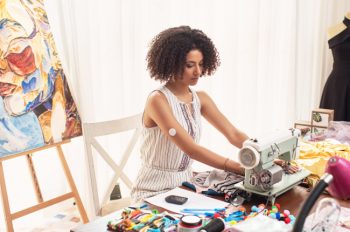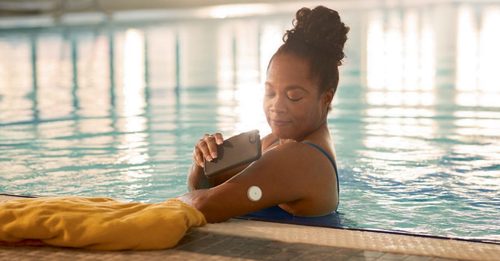Diabetes Mellitus is responsible for more than six million annual deaths around the world, and is an understated pandemic.1 Diabetes is a condition where there is either an insulin deficiency, or an inappropriate reaction to insulin.1 This leads to increased blood glucose levels that can be dangerous to the body.
Insulin is the hormone responsible for controlling glucose levels in the body. According to the International Diabetes Federation (IDF), one in eleven people currently live with diabetes. Only one out of two patients are aware of their condition.
Diabetes is associated with an increased risk of complications, and a reduction in quality of life and life expectancy.1-3
Complications of diabetes include blindness, kidney failure and the possible loss of a limb through amputation.1 Consequences are not only limited to the physical, but also include the psychological.2,4
Depression can develop in 25-50% of people living with diabetes.4 Diabetes leads to a decrease in life expectancy, shortening lives with an average of six years.5,6 The combination of diabetes and a heart attack can, in addition, shorten life expectancy by an additional six years.5 Poor glucose control accelerates the onset of complications.1
However, exceptional advances in treatment have been made in the past two decades.
Diabetes treatments today focus on improved glucose control, preventing complications, and improving quality of life and survival. A healthy lifestyle, including a healthy and balanced diet and physical activity, form the basis of any diabetes treatment plan.1 Diabetes is further managed through medication and regular monitoring of blood glucose levels.
Technological advancements have led to improved and more convenient blood glucose monitoring levels.1
In the past, blood glucose monitoring used to be very cumbersome, time-consuming, and painful. Glucose was initially measured in the urine and was followed by drawing blood through a laboratory. The glucose meter, or glucometer, is currently the most common means used to measure blood glucose.
A fingerstick* is done, and through a small volume of blood, determines the glucose level at that point in time. These are cost effective measurements, but their limitation does not reflect glucose levels that range for 24 hours. Sensing technology is currently the latest form of monitoring.

Sensor technology enables the patient and/or caregiver to continuously monitor glucose levels. This is done through a sensor that the patient wears on their body (on the back of the upper arm), and scanning with a compatible smartphone# to get a glucose reading. The sensor lasts for 7 – 14 days, depending on the system. There are mainly three systems available in South Africa.
While the device is in use, the patient can continue with normal daily activities, e.g. swimming†, showering†, sleeping, attending school, or going to work. Parents can let their children go to school or send them to a camp, knowing that they have access to their child’s glucose readings through the use of apps.‡ Virtual consultations are also possible with this technology. The system that is currently most used in South Africa is the FreeStyle Libre sensor7 – the most cost effective and easy-to-use8 sensor system.
The use of sensor technology is not only convenient, with no fingersticks* required, it also provides individualized care. It improves glucose control, reduces the risk of complications of diabetes as well as the need for additional medication, and improves quality of life.

Insulin was discovered a century ago and has since been used for the treatment of diabetes. Today, people living with diabetes have a better quality of life because of advancements in medicine and glucose monitoring solutions.
For more Information, visit www.FreeStyleLibre.za.com
*A fingerstick test using a blood glucose meter is required during times of rapidly changing glucose levels when interstitial fluid glucose levels may not accurately reflect blood glucose levels or if hypoglycaemia or impending hypoglycaemia is reported by the system or when symptoms do not match the system readings.
†Sensor is water resistant in up to 1 meter (3 feet) of water. Do not immerse longer than 30 minutes.
#The FreeStyle LibreLink app is only compatible with certain mobile devices and operating systems. Please check the website for more information about device compatibility before using the app. Use of FreeStyle LibreLink requires registration with LibreView.
‡Use of FreeStyle LibreLink requires registration with LibreView. Automatic upload requires a wireless internet connection or mobile data connection.
†The LibreView website is only compatible with certain operating systems and browsers. Please check www.libreview.com for additional information.
References:
- IDF Diabetes Atlas 2021, 10th Edition. Available at: www.diabetesatlas.org Date Accessed: July 2023.
- Tomic D, et al. Nature Reviews Endocrinology 2022;18:525-539.
- Gómez-Pimienta E, et al. International Journal of Environmental Research and Public Health 2019;16:2652.
- CDC. Diabetes and Mental Health. Available at: https://www.cdc.gov/diabetes/managing/mental-health.html Date Accessed: July 2023.
- Kianmehr H, et al. JAMA Network Open 2022;5(4):e227705.
- CDC. People With Diabetes Can Live Longer by Meeting Their Treatment Goals. Available at: https://www.cdc.gov/diabetes/resources-publications/research-summaries/reaching-treatment-goals.html#print Date Accessed: July 2023.
- Abbott Internal Data. June 2023.
- Data on File, Abbott Diabetes Care, Inc.
© 2023 Abbott. The sensor housing, FreeStyle, Libre, and related brand marks are marks of Abbott. Abbott Laboratories S.A. (Pty) Ltd., Abbott Place, 219 Golf Club Terrace, Constantia Kloof, 1709. Tel: (011) 858-2000. Fax: (011) 858 2137. ADC-79859 V1 Aug 2023.
ALSO SEE:
Here’s what you can eat to reduce the risk of type 2 diabetes
Feature Image and copy supplied by Abbott.

